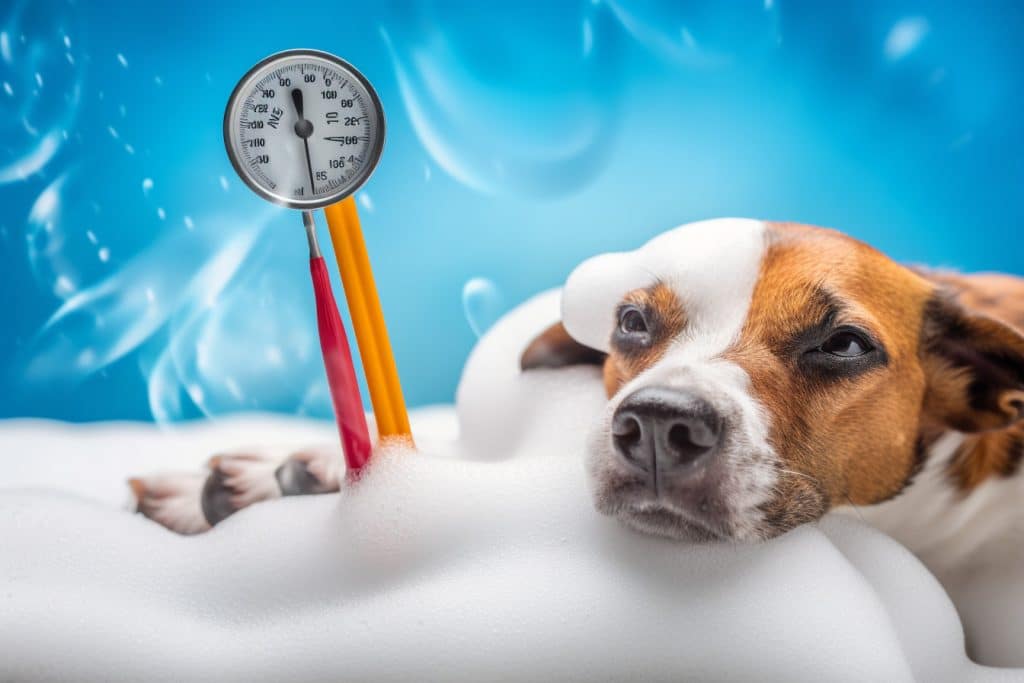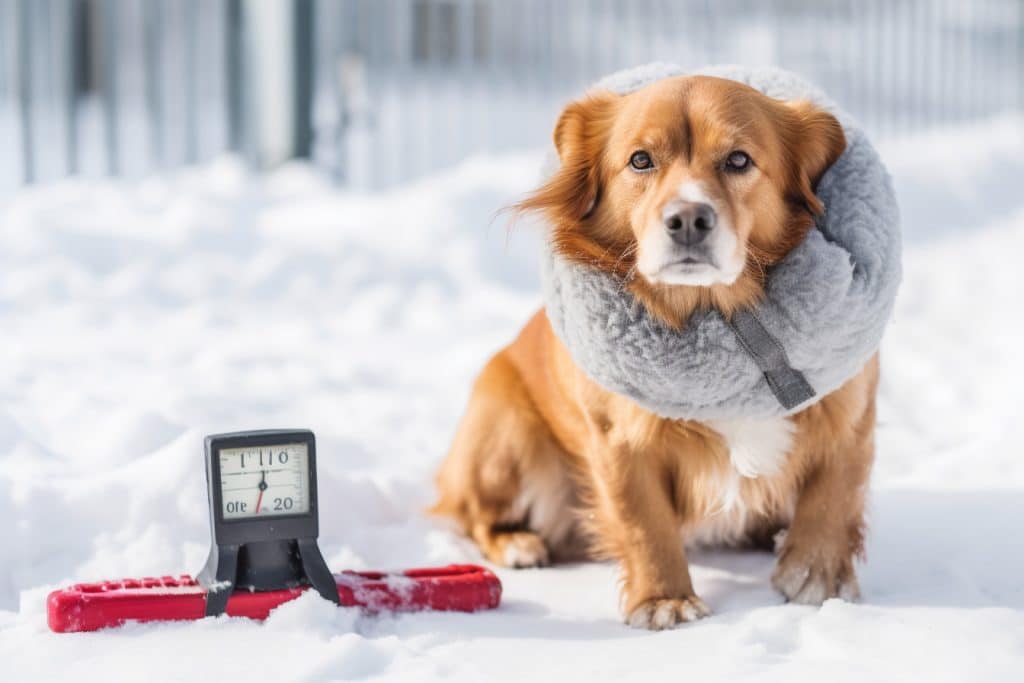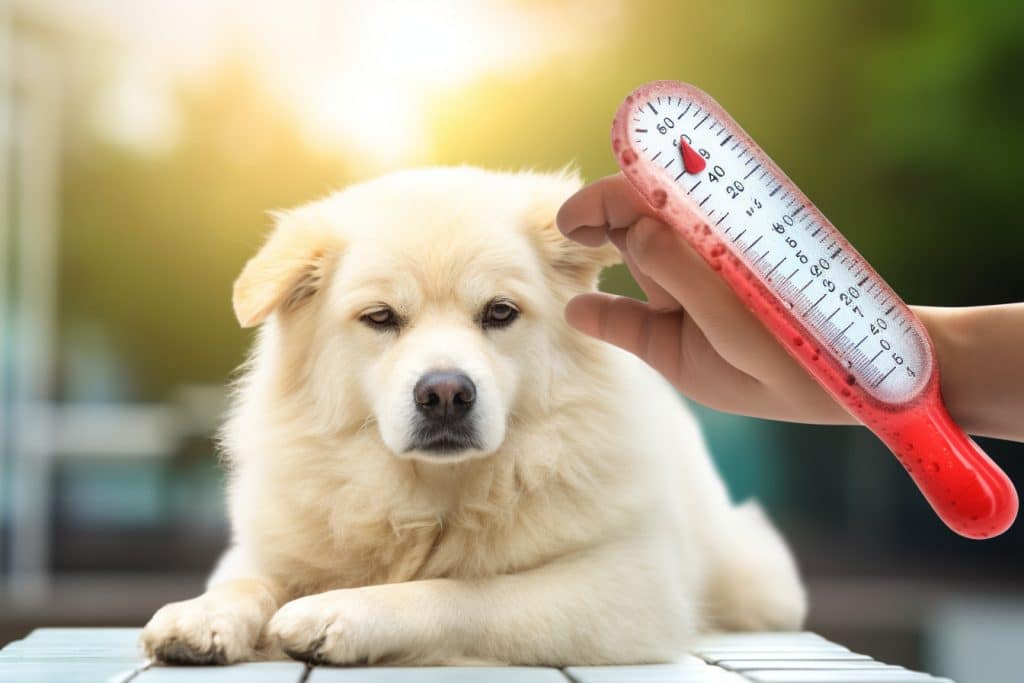What temperature is safe for dogs to walk in
As dog owners, we're constantly trying to find that ‘just right' temperature for our furry friends to enjoy their walks. After all, we want the best for our dogs, and keeping them comfortable while getting their daily exercise is essential.

Frankie, my French Bulldog, suffers terribly with sore paws on occasions, especially in the summer months.
Knowing what temperature is safe for dogs to walk in can be a bit tricky, but it's crucial in ensuring their well being and happiness. In this article, we'll explore the various factors that determine a dog's tolerance to different climates and temperatures.
We'll provide guidelines on safe walking conditions for your beloved pet and discuss how to recognize signs of distress when they're feeling too hot or cold.
Additionally, we'll share some tips on choosing the best time of day for those walks and how to care for your dog after a stroll in extreme temperatures.
Our goal is not only to educate ourselves but also empower each other with knowledge so that we can continue providing the ultimate care and love our dogs deserve.
Understanding a Dog's Tolerance to Heat and Cold
As a loving pet owner, myself, it's essential to know your furry friend's limits when it comes to braving the elements and venturing outdoors with them.

Each dog has its unique temperature perception and tolerance levels to both heat and cold, so understanding your canine companion's specific needs is crucial for their well-being.
Dog heat tolerance varies by breed, size, age, and overall health; for example, dogs with thick coats or short snouts often struggle more in hot weather. Frankie’s best friend Murphy is a show cocker, and Steve, his owner has to have him sheared regularly from April to October.
Similarly, cold tolerance in dogs can differ significantly too – some breeds are built for colder climates while others are not. Keeping an eye on outdoor temperature for pets and monitoring their behavior during walks can help you ensure their safety in different climate conditions.
To best care for our four-legged friends during extreme temperatures, we need to be aware of signs indicating discomfort or distress due to the weather. For instance, excessive panting or drooling may indicate that your dog is overheating and requires a break in the shade or indoors. On the other hand, shivering or seeking warmth could signal that they're feeling too cold.
A regular canine temperature check will also aid in determining if your pup's body temperature is within a safe range (typically between 101°F-102°F). By staying informed about pet safety measures in different climates and catering to each dog's unique heat and cold tolerance levels, we'll ensure our beloved companions remain comfortable no matter what Mother Nature throws at us!
Safe Temperatures for Dogs in Different Climates
Generally speaking, what temperature is safe for dogs to walk in, during cold weather is around 45°F (7°C) or higher while anything above 80°F (27°C) may be too hot for most dogs, it certainly is for mine.

However, some breeds like Huskies and Malamutes are better suited for colder climates while short-haired breeds like Greyhounds may prefer warmer temperatures. Walking dogs in winter requires extra care and attention to avoid frostbite or hypothermia, so always monitor your dog's comfort during these chilly outings.
When it comes to walking dogs in summer or hot climates, keep an eye out for signs of overheating such as excessive panting, drooling, weakness or even collapse. Dog breeds with flat faces like Pugs and Bulldogs are particularly prone to heatstroke due to their breathing difficulties in high temperatures.
To ensure your pet's comfort and safety during walks in different temperatures, it's crucial to learn about dog breeds' temperature sensitivity and adjust accordingly. Additionally, make sure they have adequate hydration before embarking on any outdoor adventures together by providing them with plenty of water throughout the day.
By understanding your pup's specific needs based on their breed and individual characteristics, you'll be able to provide them with optimal care no matter the climate!
Recognizing Signs of Distress in Your Dog Due to Temperature
Knowing when your furry friend is experiencing discomfort due to weather conditions can be a lifesaver, so let's dive into recognizing the signs of distress in your dog and how to help them out!

Recognizing signs of distress in your dog due to temperature is essential for ensuring safe dog walks. When the temperature is too hot, dogs may exhibit symptoms such as excessive panting, drooling, increased heart rate, weakness or lethargy, vomiting or diarrhea, disorientation, or even collapsing.
In colder temperatures, signs of hypothermia include shivering, cold ears and paws, pale gums and mucous membranes, weakness or lethargy, decreased responsiveness to stimuli or commands. By being aware of these potential issues while walking your dog in various climate conditions, you can take proper action like seeking vet advice for dog walks if needed.
Dog walking safety tips also include monitoring their hydration levels closely during extreme temperatures. Dog hydration and temperature go hand-in-hand; providing fresh water before and after walks is crucial to help regulate their body temperature. Additionally, carrying a collapsible water bowl ensures they have access to water during longer walks.
It's important that we remain observant on our walks with our canine companions. If you notice any unusual behavior that may indicate they are uncomfortable due to the weather conditions (like seeking shade when it's hot outside), adjust accordingly by shortening the walk duration or altering the route where necessary shade can be found.
Remember that we are responsible for their well-being during these adventures together – always prioritize safe dog walks over pushing through unfavorable conditions!
Best Time of Day for Dog Walks
The best time to walk dogs depends on various factors like weather conditions, your dog's breed and size, as well as individual preferences.
However, generally speaking, early mornings and late evenings are ideal for a dog walking routine since these times usually have cooler temperatures and less direct sunlight. This helps protect your pet from overheating and reduces their risk of burning their paws on hot pavement.

To make sure you're providing the safest environment for your dog during walks, consider these helpful tips:
– *Pavement temperature for dogs*: Test the ground by placing your hand or bare foot on it; if it's too hot for you to hold or stand comfortably within 5 seconds, it's too hot for your pup.
– *Exercise for dogs in heat*: Avoid intense activities during high temperatures; instead opt for shorter walks or indoor games.
– *Exercise for dogs in cold*: Keep an eye out for signs of discomfort due to cold weather such as shivering or reluctance to move; provide appropriate clothing if necessary.
– *Dogs and weather conditions*: Be mindful of humidity levels and adjust exercise; accordingly, ensure that water is always available before, during, and after walks.
By being attentive to these factors while planning your daily dog walking routine, you can ensure that both you and your furry companion enjoy a safe and healthy bonding experience outdoors.
Safety Tips for Walking Dogs in Extreme Temperatures
Navigating extreme weather conditions while ensuring your canine companion's well-being may seem challenging, but with proper precautions and awareness, it's certainly achievable. Being mindful of what temperature is safe for dogs to walk in, is crucial when taking them out for walks in extreme temperatures.
As responsible pet owners, it's our duty to adapt to weather changes and implement safety tips that'll protect our furry friends from harm during both hot and cold seasons.
Firstly, when walking dogs during hot weather, avoid going outside during peak hours (usually around 10 a.m. to 4 p.m.), as this is when the sun's rays are strongest. Instead, opt for early morning or late evening walks when the temperature has cooled down. Make sure to test the pavement with your hand or bare foot; if it's too hot for you, it's too hot for your dog's paws as well.

Always provide plenty of water before, during, and after walks to prevent dehydration.
On the other hand, walking dogs in cold temperatures requires proper insulation through coats or sweaters specifically designed for canines and booties to protect their paws from ice and chemicals used on roads. Be aware of signs indicating hypothermia such as shivering or lethargy in your pet; immediately seek warmth if these symptoms occur.
By being cautious and attentive towards our pets' needs during dog walks in extreme temperatures, we not only ensure their safety but also continue nurturing that special bond between us and our beloved companions.
How to Care for Your Dog After a Walk in Extreme Temperatures
It's essential to provide proper aftercare for your pup following a stroll in harsh weather conditions, ensuring their comfort and well-being. Whether you're dealing with extreme heat or frigid cold, understanding what temperature is safe for dogs to walk in is crucial in preventing injuries and keeping them healthy.
After returning from any walk in extreme temperatures, it's important to check your dog thoroughly for any signs of distress or injury. This includes inspecting their paws for burns or frostbite, as well as monitoring their behavior for indications of heat exhaustion or hypothermia.

Remember that recognizing dog distress signs early on can make all the difference when it comes to caring for dogs in heat or cold.
One key aspect of aftercare involves providing ample hydration and maintaining a comfortable environment post-walk. Make sure fresh water is readily available to help regulate your dog's body temperature after exposure to extreme conditions.
Additionally, utilizing cooling mats or warming blankets can assist in bringing them back to a comfortable state more quickly.
For added safety measures, consider investing in dog paw protection gear such as booties or balms (worth their weight in gold, the hard part is putting them on lol) specifically designed for walks during harsh weather conditions. By taking these steps and being vigilant about our furry friends' needs, we not only ensure they stay comfortable but also foster a strong bond built on trust and compassion.
Thoughts
I can't stress enough the importance of paying close attention to our furry friends when out for a walk in extreme temperatures. Just as we wouldn't want to suffer through unbearable heat or bone-chilling cold, neither should our dogs.
Let's remember the story of that dog who was saved just in time from heatstroke on a hot summer day. It's a reminder that our canine companions rely on us to keep them safe and comfortable.
Together, let's ensure their well-being by being responsible and compassionate pet owners.



